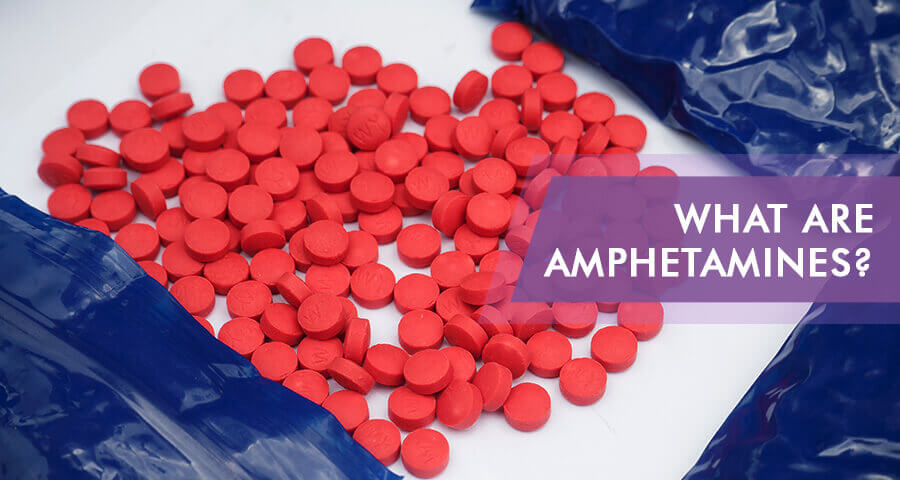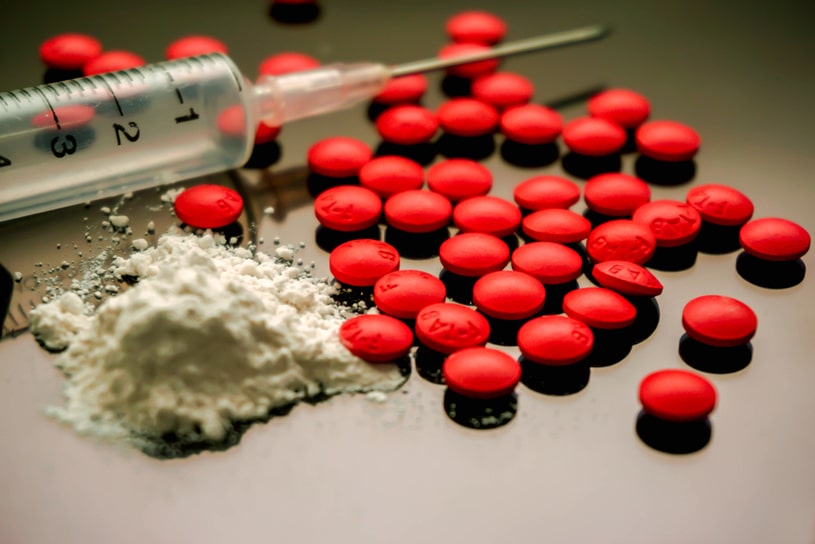
Amphetamines are a group of drugs that are classified as stimulants. Some amphetamine drugs are legal and are found in prescription medication. Other amphetamines are illegal drugs and their production is unregulated. Many amphetamine drugs, whether legal or illegal, are abused recreationally.
Table Of Contents:
- What is the Amphetamine Group of Drugs?
- What Are the Causes of Addiction?
- What Are Some Facts on the Abuse of these Substances?
- What Are the Signs and Symptoms of Abuse?
- What Are the Short-Term and Long-Term Effects of Abuse?
- What Is Amphetamine Overdose?
- How Is the Drug Metabolized?
- What Are the Symptoms of Withdrawal?
- How Is Addiction to the Drug Treated?

Heavy amphetamine use can result in addiction. When addiction runs unchecked, there can be significant side effects. There is also the risk of overdose. This is why it is important to address addiction to amphetamine drugs before it is too late.
What is amphetamine? What are the symptoms and side effects of this group of drugs? This article will answer all of those questions and more.
What is Amphetamine?
Amphetamines are a group of drugs that act as stimulants on the central nervous system, increasing its activity. Legally, amphetamine drugs are sold as a prescription medication for the treatment of conditions like attention-deficit hyperactivity disorder (ADHD) and narcolepsy. However, these medications are sold illegally on the street as a recreational drug or produced in street labs for the same purpose.
The amphetamine group of chemicals includes the following:
- Amphetamine
- Dextroamphetamine (d-amphetamine)
- Methamphetamine
Many of the prescription medications in this group combine different amphetamine salts in order to produce their effect.
Some examples of prescription amphetamine drugs include:
- Adderall (amphetamine-dextroamphetamine)
- Evekeo (amphetamine sulfate)
- Desoxyn (methamphetamine hydrochloride)
There are also illegal methamphetamines, which are drugs like crystal meth or speed.

More About Stimulants:
These prescription amphetamine drugs treat a wide array of conditions. Desoxyn is used for treating obesity as it suppresses appetite. Adderall and Evekeo are used in the treatment of ADHD in children older than 3, as well as narcolepsy in adults. It is also used to treat depression though this is an off-label use.
Amphetamine Addiction Causes
Amphetamines are a class of drugs that work to stimulate the central nervous system. When taken in therapeutic doses, these drugs create emotional and cognitive effects that include feelings of euphoria, increased sex drive, increased energy, decreased appetite, and improved cognitive control. Physically, amphetamines taken in therapeutic doses can lead to better reflexes, decreased fatigue, and increased strength. When taken in recreational doses, many of the effects become reversed. For example, cognitive function may become impaired rather than improved, and muscles may break down rather than increase in strength.
Common causes of addiction to amphetamines include the following:
- Neurochemistry: Each individual has differences in how their CNS works. For those who produce fewer catecholamine neurotransmitters, such as dopamine, epinephrine, and norepinephrine, any drug that affects their release may feel more pleasurable, promoting abuse.
- Genetics: If a person has a close relative who suffers from addiction, there is a chance that they have a genetic predisposition for it. This increases the likelihood of them developing dependence, particularly if their relative was also addicted to a stimulant drug.
- Life stressors: These drugs can help relieve feelings of both mental and physical stress. If an individual finds it difficult to cope with stress, it is probable that they may turn to amphetamine drugs in order to deal with it.
- Peer pressure: People are pressured to have a certain body figure or to use drugs when among friends. Amphetamine drugs suppress appetite and people may see them as a good way to lose weight initially, but soon get addicted. Others may try it once at a party or because of friends, and soon find themselves dependent.
- Social anxiety: When meeting new people, many people can be nervous. They may hear that amphetamine drugs help to disinhibit them when among other people. It is using it for purposes like this that may lead a person into dependence.
- Performance enhancing: In younger populations, Adderall tends to be abused prior to exams and tests as it produces some improvements in memory, concentration, and cognition that are found to be beneficial to these younger people. Depending on the drug for these effects too frequently can spiral into addiction.
Abuse of amphetamines is possible in anyone but there are some risk factors which when present can increase the chances of dependence developing. These include:
- Access to amphetamine drugs
- Presence of significant stressors such as stressful work or school
- Living in an area where addiction to amphetamines is prevalent
- Having a mental disorder
- Dealing with self-image issues
- Having financial problems.
Heavy amphetamine use can cause significant damage to an addict’s health and life.
On a long-term basis, the use of the drug can result in changes to the brain and neurochemistry, weight loss and muscle loss, anorexia nervosa, and more.
In certain occupations, heavy amphetamine use can put others at risk, such as when driving or operating heavy machinery. Overdose of amphetamines is a major risk of abusing these drugs or medication.
A person who consistently abuses the drug may develop tolerance, which means they need to increase the dose to achieve the same effect. This can be dangerous as larger amounts of the drug have more toxic effects on the body.
Amphetamine-Dextroamphetamine Use Facts and Statistics
When it comes to heavy amphetamine use, the numbers really show the prevalence of misuse. Adderall is the most abused drug in its class, with over 25 million prescriptions in its class in 2018. Below are some of the statistics associated with heavy amphetamine use:
- In the 2019 National Survey on Drug Use and Health, nearly 5% of respondents claimed to have abused amphetamines at one point or the other in their life.
- Almost 2% of respondents had used the drug in the previous year. This is an assessment of those who may be considered active abusers of amphetamine drugs.
- 18-25-year-olds were the most common active abusers of amphetamine drugs, with 41% of them having used the drug in the past year.
- The second most represented age group were those between 26 and 34 years of age, making up 30% of the active users.
- Men were more likely to abuse the drug, with 57% of active users being male.
- Unemployed individuals were the most likely to be active abusers of amphetamine drugs. Out of all the unemployed respondents, over 3% had used amphetamine drugs in the last year. The least likely to use amphetamine drugs were people with full-time employment. Only 1.9% of them had used any of these drugs in the last year.
- Regarding Adderall, one study found a 67% increase in non-medical use of the drug over 6 years and a 156% increase in emergency visits to the hospital related to its use.
- There is a worrying trend in the use of methamphetamine among high-schoolers, with 1.4% of 12th graders admitting to having used the drug in the last year.
- Lifetime use of methamphetamine was 6.5% in those older than 26, though use in the last year was mostly seen in young adults aged 18 to 25.
The abuse of stimulant drugs such as amphetamines is a growing problem in the United States. This amphetamine addiction crisis saw deaths related to its abuse rise 10-fold between 2009 and 2019.
Men were nearly three times more likely to die from stimulant overdose than women. Most individuals who died from overdose were caucasian, making up 65.2% of overdose deaths. While abuse of amphetamine drugs is very prevalent in younger people, deaths were most likely to occur in those aged between 45 and 54 years of age.
Amphetamine Abuse Signs and Symptoms
Due to the fact that they all belong to the same group, many amphetamine drugs share similar effects. There may be a few symptoms specific to some drugs though. If a relative or loved one is suspected to be abusing amphetamine drugs, there are some symptoms or signs that may be able to be observed.

These signs and symptoms can be divided into physical, psychological, behavioral, and social signs, as follows:
Behavioral Symptoms
Heavy amphetamine use can result in some changes to the behavior of an individual. These symptoms are due to dependence and tolerance developing and the addict doing what they must to maintain abuse.
- Taking larger doses than prescribed
- They are unable to cut down on their frequency or dosage
- They put in a lot of effort in order to obtain amphetamine drugs, which may include visiting multiple doctors to maintain their prescriptions
- A short-lived increase followed by a decline in performance at school or work
- Using the drug in situations where it can pose a hazard to themselves or others
- Neglect of previously enjoyed activities
- Borrowing money frequently or selling/stealing valuables
In those who abuse crystal methamphetamine, the following behavioral signs may be seen in addition to the symptoms above:
- Aggression
- Irritability
- Neglect of personal hygiene
Psychological Signs
The effects that these amphetamine drugs have on a person’s neurochemistry will begin to manifest the longer they use the drug.
- More sociable and talkative
- An increase in confidence may lead to overestimating their ability
- Difficulty sleeping
- Loss of appetite
Social Symptoms
The social life of a person addicted to amphetamines will take a toll. The need to abuse the drug takes precedence over relationships that previously held importance to them.
- They are unable to read social cues and situations
- They are overly social or manic with how they interact with people
- They struggle with social problem solving
- Important relationships become distressed
Physical Signs
Amphetamine drugs cause an array of physical symptoms due to their direct effect on the body. These symptoms may differ in their extent slightly depending on which amphetamine drugs are being abused. One like Evekeo will show these symptoms, but due to its short-acting nature, they resolve faster than with drugs like amphetamine-dextroamphetamine.
- Increased blood pressure
- Rapid breathing
- Elevated body temperature
- Increased energy
- Increased libido
- Restlessness
- Dilated pupils
- Development of tolerance
Evekeo can sometimes cause mild itching. Crystal methamphetamine abuse can result in formication, which is a sensation of insects crawling on the skin.
Amphetamine Abuse Effects
Amphetamine salts differ slightly from one another, though their chemical structure shares a lot of similarities. Many of the effects that are seen following the use of amphetamine drugs are similar to the others, though there are a few symptoms that may not be as common with some drugs as others in the group. These effects can either be seen very shortly after use or in the long-term. The symptoms below are the average symptoms seen for drugs in this family.
Short-Term Amphetamine Effects
In the minutes following consumption of amphetamine drugs, the user may begin to notice some effects which may persist for minutes to hours, depending on the dose used.
These short-term effects include the following:
- Changes in sleep pattern, such as difficulty falling asleep or waking up
- Loss of appetite
- Muscle spasms
- Increased body temperature
- Increased heart rate
- Increased blood pressure
- Increased energy
- Bipolar behavior
- Temperamental
- Emotional detachment or depressed behavior
- Increased sexual arousal (though occasionally decreases)
Long-Term Amphetamine Effects
Amphetamine drugs are very likely to cause the following effects in addicts who abuse the drug in the long-term. The changes that these drugs cause on the neurotransmitters in the central nervous system are more difficult to reverse, the longer the person has been abusing the drug.
These include the following:
- “God complex”, grandiosity, or overblown ego
- Social withdrawal
- Persisting aggressive behavior
- Mood swings
- Psychotic symptoms such as delusions and hallucinations
- Malnutrition
- Skin disorders
- Seizures
- Tics
- Impaired muscle coordination
Amphetamine Overdose
When the dosage of a drug used is significantly over the prescribed and safe limit, there is a risk of an overdose occurring. For this group of drugs, overdose can be fatal if medical attention is not received. It is important to avoid this potential danger by addressing the addiction problem as early as possible.
Amphetamine Overdose Signs and Symptoms
Due to their close similarities with one another, the symptoms are seen when an individual overdoses on amphetamine drugs tend to be very similar. As a stimulant, these symptoms are related to central nervous system excitation.
They include:
- Severely elevated body temperature (hyperthermia)
- Increased blood pressure
- Rapid breathing
- Racing heartbeat
- Enlarged pupils
- Excessive tremors
- Excessive sweating (diaphoresis)
- Vomiting
- Restlessness and hyperactivity
- Seizures
- Hallucinations
- Frequent muscle spasms
- Blurred or double vision
- Aggressiveness
- Paranoia
- Panic
If multiple of these symptoms are noticed in an individual who just abused any one of the amphetamine drugs, there is a high chance that they are experiencing an overdose. They should be taken for emergency care immediately.
Amphetamine Overdose Effects on Body and Brain
These medications possess mind-altering properties. They do so by changing the levels of certain chemicals in the brain. These brain chemicals, also called neurotransmitters, enable communication between brain cells. Moreover, being fat-soluble or lipophilic, they reach the brain rapidly after consumption.
Neurotransmitters also affect many parts of the body in different ways. For example, they may affect memory, emotions, thinking ability, and other physiological functions.
Amphetamine drugs increase the activity of the neurotransmitters dopamine and norepinephrine in the brain. In addition, they also induce the release of other neurotransmitters. They are epinephrine, histamine, and serotonin.
Having high levels of dopamine in the brain gives a feeling of pleasure and reward. Of course, this is the reason why amphetamine drugs are very addictive, and quitting is such a tough task.
When one overdoses, the first set of symptoms is mainly excitatory in nature. However, within hours, the binding sites of amphetamines in the brain will become full. After, when the excitation plunges, the symptoms of depression begin to manifest.
Overdose of amphetamine drugs has been linked to causing permanent damage to the neurons in the brain that have receptors for dopamine and serotonin. This means that an overdose or continuous abuse can completely change how the brain responds to these neurotransmitters.
Due to the effects that amphetamine drugs have on a section of the nervous system known as the sympathetic nervous system, overdose can cause damage to other systems of the body by causing them to malfunction. For instance, they will cause tachycardia by stimulating the sympathetic nervous system. This can lead to arrhythmias, hypertension, and even a heart attack. They have several effects on the cardiovascular system.

Amphetamines also damage the brain by greatly increasing the blood flow to the brain. This can result in spontaneous bleeding in the brain, which is stroke. These drugs can also result in the death of muscle tissue, which adds to the effects of weight loss.
The effects that amphetamines can have on the body and brain are numerous and many of them irreversible.
Amphetamine Overdose Death
Using amphetamine drugs at a dosage greatly above the prescribed one increases the chance of overdose. Overdose can cause death though it is a relatively rare occurrence.
Not only does a high dosage increase the chance of overdose but so does abusing amphetamines with other drugs. Long-standing cardiovascular diseases such as hypertension and congenital heart diseases also increase the risk of dying due to overdose.
There are some symptoms that can typically be seen prior to death by overdose. These are symptoms like hyperthermia, seizures, and dangerously low blood pressure.
One study found that common causes of death among abusers of amphetamines were cardiac arrest, stroke, and hyperthermia.
The increased breakdown of muscle tissue during an overdose can present with complications of its own. If severe, the excessive muscle breakdown products can overwhelm the kidneys and cause kidney failure. This is another route by which overdose on amphetamines can be fatal.
Stimulant Psychosis
Psychosis induced by an overdose on amphetamine drugs is a rare occurrence but it can happen. It is a serious medical condition that will require emergency care.
The symptoms typically include:
- Visual or auditory hallucinations
- The sensation of insects crawling on or under the skin (formication)
- Severe anxiety
- Paranoia and panic attacks
The frequency of heavy amphetamine use and the degree of severity of the dependence are two risk factors that increase the chance of stimulant psychosis occurring.
It is thought that approximately 40% of those who abuse these drugs may have experienced psychotic symptoms at some point.
Amphetamine Metabolism
Drugs in this class dissolve in fats and oils very easily. They get absorbed easily into the intestinal system thanks to their propensity for fatty tissue. From there, they get moved into the bloodstream.
Once amphetamines are in the vessels, they attach to certain proteins in the blood. After about 3 hours, the drug begins to fade from the blood. It is being cleared out of the body thanks to the kidneys.
Amphetamines are basic substances, when they are being passed out through the kidney, how alkaline or acidic the urine determines the half-life and how long it will be metabolized. When it is basically like the drug, it lasts longer in the urine.
The half-life of amphetamine drugs can essentially double in the presence of alkaline urine as opposed to acidic urine.
Amphetamine Duration in Different Body Fluids and Hair
Due to the slight differences in their chemistry and action, these drugs can be detected in the body for variable amounts of time. In general, they are closely related in terms of their detection periods. Heavy amphetamine use will lengthen the time in most cases.
| Urine | Blood | Saliva | Hair | |
| Adderall | 3 to 4 days | About 2 days | Up to 2 days | Up to 3 months |
| Evekeo | Up to 3 days | 4 to 6 hours | 1 to 2 days | Up to a month |
| Vyvanse | Up to 8 hours | Up to 3 days | Up to 2 days | Up to a month |
| Methamphetamine | Up to a week in heavy users | 1 to 3 days | Up to 4 days | Up to 3 months |
Amphetamine Withdrawal Symptoms
Amphetamine drugs tend to display a common set of withdrawal symptoms, though there may be some differences between them. This section will discuss those most likely to be seen with any of this group’s medication.
Below is the DSM Criteria for diagnosing amphetamine withdrawal syndrome:
- The user ends or reduces their use of amphetamines after having used them for a prolonged period of time
- A dysphoric mood results
- Two or more of the following develop within hours or days after ending or reducing usage: fatigue, insomnia, hypersomnia, psychomotor agitation, increased appetite, vivid, unpleasant dreams
- The symptoms cannot be attributed to another medical condition
A study in 1998 observed patients abstaining from amphetamines and was able to find your primary withdrawal symptoms which appeared in most of them:
- Irritability (seen in 78% of patients)
- Aches and pain (58% of patients)
- Depressed mood (seen in 50% of patients)
- Impaired social function (seen in 46% of patients)
Some other withdrawal symptoms that may be seen in these people include:
- Depression
- Uneasiness
- A general sense of dissatisfaction
- Sudden mood swings
- Excessive sleep
- Overeating and increased appetite
- Vivid dreams
- Irritability
- Exhaustion
- Physical agitation
- A lack of feelings of pleasure
- Slow reflexes
- Struggles to maintain eye contact
- Pale skin
- Suicidal thoughts
- A lack of animation in vocal and physical expression
- Poor judgment
Amphetamine Withdrawal Tips
The withdrawal symptoms seen depend on the exact drug used. Those who abuse street amphetamine salts such as crystal meth tend to have worse symptoms than those who abuse prescription drugs like amphetamine-dextroamphetamine. Here are some tips to help users cope:
- Patience is important. The worst parts will pass but symptoms may remain for years
- Get help. Professionals have seen many go through the same and can make the process easier
- Find a support system. Family and friends are a good option, but those with experience with addiction like recovery programs and therapists are good choices
- Remove triggers. Stress and other factors that lead to use should be eliminated, or healthy coping mechanisms should be developed
- Find hobbies. These can make life more pleasurable and remove the need for abuse
Amphetamine Withdrawal Timeline
The symptoms of withdrawal tend to appear in a rough pattern known as the withdrawal timeline.
- The first 1 to 2 days: These are known as the ‘crash’. They have increased appetite, cravings, increased sleep, and depression.
- Up to 2 weeks: Aches and pains, irritability, depression, difficulty sleeping, mood swings, fatigue.
- 2 weeks to a year: Many of these symptoms may persist in the long term as part of post-acute withdrawal syndrome. These include impaired cognition, depression, anxiety, and irritability.
Amphetamine Addiction Treatment
Treatment of addiction to these drugs is a long process and is difficult to deal with, but it is entirely possible. Addicts should get treatment as soon as possible to avoid severe side effects. However, it is never too late to get help.
Detoxification
This is the step where the amphetamines are cleared from the body. This is when the withdrawal symptoms tend to be at their peak, as the body struggles to adjust to the absence of the drugs.
It is important to detox at a professional treatment center. They have clinicians onboard to ensure the safety and wellbeing of all patients and to make the detox period as comfortable as possible. Medication is used many times in order to alleviate the discomfort that the patient feels.
The detoxification period typically lasts between 1 and 2 weeks, depending on the extent of the dependence that the patient has.
They will receive psychotherapy, medication, and may also engage in group sessions with other addicts in order to improve.
Rehabilitation and Therapies
Once detox is completed, the patient moves into rehabilitation. This aims to repair the social and psychological damage that addiction has caused and to address risk factors. Many treatment centers will want to follow up with the patient for up to a year.

Inpatient treatment is recommended in most cases, particularly for those with severe dependences. However, some addicts may not be flexible enough to stay in the center for long periods of time, so will require outpatient care. They may need to be available for at least 10 hours per day.
Addiction is not cured but can be managed, and recovery is for life. This is why it is important that the addict finds support mechanisms for the long term, such as recovery groups.
Relapse
An addict may return to the drug even after a long period of abstinence. This is known as relapse. They may believe they have failed, but relapse does not point to failed treatment. As a disease that has no cure, relapse is part of the process in many cases. Similar to other mental conditions that may return even after treatment, addiction is the same.
Common Relapse Triggers
Many addicts return to their drug abuse due to something which triggers their need for it.
The most common causes of these include the following:
- Encounters with addict friends from their past
- Stressful life circumstances
- New life changes such as a new job or school
- Major depressive episodes or life events
- Going to places with a mental connection to their addiction
Amphetamine Relapse Complications
Addiction is a disease that can reach beyond just the person’s mental health. It is important to put addiction behind one as it leads to a healthier life. Relapsing returns a person to the risk of having their health deteriorate significantly.
The complications of heavy amphetamine use can end up causing long-standing mental illness such as depression, anxiety, insomnia, and panic attacks.
It can also have a significant effect on their physical health by causing heart disease, increasing the risk of diseases like stroke, and sharing paraphernalia put them at the risk of contracting lifelong infectious diseases.
The epidemic around amphetamines is a big problem yet it does not get as much attention as the opioid crisis. Wider groups of the population are becoming susceptible to dependence on these drugs, particularly younger people, who the addiction may stay with through the most important years of their life.
It is important to tackle this problem as early as possible because recovery is possible and healthier life is just within reach for addicts.
Find Drug Rehabilitation Centers Near You Anywhere In the US
Addiction Resource team has compiled an extensive list of the top drug rehabilitation facilities around the country. Use our locator tool to find the best centers near you.
Page Sources
- Spencer R, DeVilbiss D, Berridge C, The Cognition-Enhancing E The Cognition-Enhancing Effects of Psychostimulants Involve Direct Action in the Prefrontal Cortex, 2015, https://rdw.rowan.edu/cgi/viewcontent.cgi?article=1056&context=som_facpub
- Chen LY, Crum RM, Strain EC, Alexander GC, Kaufmann C, Mojtabai R, Prescriptions, nonmedical use, and emergency department visits involving prescription stimulants, 2016, https://www.ncbi.nlm.nih.gov/pmc/articles/PMC5903919/
- National Institute on Drug Abuse, Methamphetamine Trends & Statistics, 2020, https://www.drugabuse.gov/drug-topics/methamphetamine/methamphetamine-trends-statistics
- Volkow N, Rising Stimulant Deaths Show that We Face More than Just an Opioid Crisis, 2020, https://www.drugabuse.gov/about-nida/noras-blog/2020/11/rising-stimulant-deaths-show-we-face-more-than-just-opioid-crisis
- O’Donnell J, Gladden R, Mattson C, Hunter C, Davis N, Vital Signs: Characteristics of Drug Overdose Deaths Involving Opioids and Stimulants — 24 States and the District of Columbia, January–June 2019, 2020, https://www.cdc.gov/mmwr/volumes/69/wr/pdfs/mm6935a1-H.pdf
- Cunha J, Evekeo Vs. Adderall, 2020, https://www.rxlist.com/evekeo_vs_adderall/drugs-condition.htm
- Steinkellner T, Freissmuth M, Sitte HH, Montgomery T, The ugly side of amphetamines: short- and long-term toxicity of 3,4-methylenedioxymethamphetamine (MDMA, 'Ecstasy'), methamphetamine and D-amphetamine, 2011, https://www.ncbi.nlm.nih.gov/pmc/articles/PMC4497800/
- Vasan S, Olango GJ, Amphetamine Toxicity, 2020, https://www.ncbi.nlm.nih.gov/books/NBK470276/
- White SR, Amphetamine toxicity, 2002, https://pubmed.ncbi.nlm.nih.gov/16088595/
- Kalant H, Kalant OJ, Death in amphetamine users: causes and rates, 1975, https://www.ncbi.nlm.nih.gov/pmc/articles/PMC1956334/
- Richards J, Johnson E, Stark R, Derlet R, Methamphetamine abuse and rhabdomyolysis in the ED: A 5-year study, 1999, https://www.sciencedirect.com/science/article/abs/pii/S0735675799901596
- Arunogiri S, Foulds J, McKetin R, Lubman D, A systematic review of risk factors for methamphetamine-associated psychosis, 2018, https://journals.sagepub.com/doi/full/10.1177/0004867417748750
- Glasner-Edwards S, Mooney LJ, Methamphetamine psychosis: epidemiology and management, 2014, https://www.ncbi.nlm.nih.gov/pmc/articles/PMC5027896/
- Anggard E, Jonsson L, Hogmark A, Gunne, L, Amphetamine metabolism in amphetamine psychosis, 1973, https://ascpt.onlinelibrary.wiley.com/doi/abs/10.1002/cpt1973145870
- Australian Government Department of health, The amphetamine withdrawal syndrome, 2004, https://www1.health.gov.au/internet/publications/publishing.nsf/Content/drugtreat-pubs-modpsy-toc~drugtreat-pubs-modpsy-3~drugtreat-pubs-modpsy-3-7~drugtreat-pubs-modpsy-3-7-aws#amp
- Watson R, Hartmann E, Schildkraut J, Amphetamine Withdrawal: Affective State, Sleep Patterns, and MHPG Excretion, 2006, https://ajp.psychiatryonline.org/doi/abs/10.1176/ajp.129.3.263
- Haj-Mirzaian A, Amiri S, Amini-Khoei H, et al, Involvement of NO/NMDA-R pathway in the behavioral despair induced by amphetamine withdrawal, 2018, https://www.sciencedirect.com/science/article/abs/pii/S0361923017306159
- Semel Institute for Neurosciece and Human Behavior, Post-Acute Withdrawal Syndrome, https://www.semel.ucla.edu/dual-diagnosis-program/News_and_Resources/PAWS
- National Institute on Drug Abuse, Drugs, Brains, and Behavior: The Science of Addiction - Treatment and Recovery, 2020, https://www.drugabuse.gov/publications/drugs-brains-behavior-science-addiction/treatment-recovery


 Reviewed by:
Reviewed by:  Written by:
Written by: 

 FindTreatment.gov
FindTreatment.gov